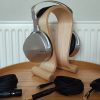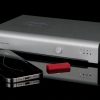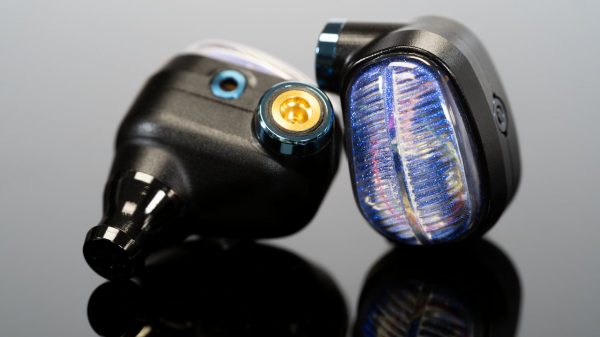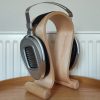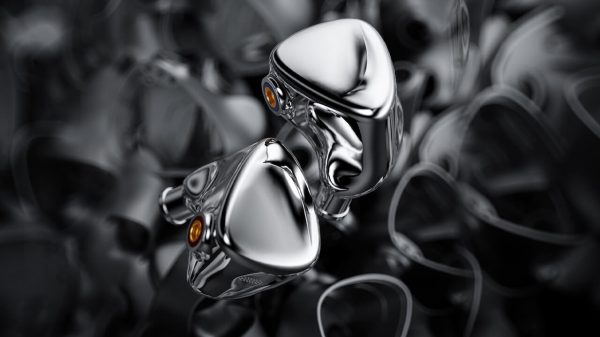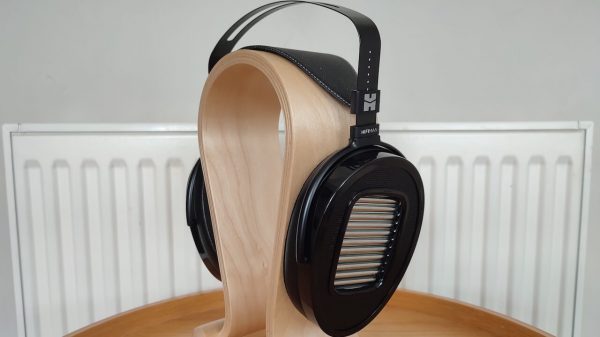By Paul Schumann

High-end headphones have become very expensive. It’s no longer unusual to find IEMs, closed-back planar magnetic, and open-back dynamic headphones selling for $3,000 – $5,000. Most consumers can’t justify spending that kind of money for a pair of headphones for their iPhone or DAP. The FiiO FD5 IEMs retail for $299 and they might be the best kept secret in affordable high-end headphones.

You can teach an old dog new tricks!
As I approach the big 6-0, I have become more mindful of the choices I make and how I spend my time. I am constantly asking myself, “How can I get the most out of this day?” Sure, I still waste too much time on Facebook and YouTube, but I still try to block out some time each day for something that will challenge me in some way. It might be trying a new recipe, coming up with a new teaching strategy, working on a new audio equipment project, listening to a new challenging piece of music, attempting a new yoga pose, or watching a new show. Included in this endeavor is reviewing new and different pieces of equipment.
Thanks to Steven’s benevolent leadership, I have been able to listen to, and write about a wide variety of high-end pieces of equipment from all over the world. As of December, items still on my bucket list were a turntable, a power conditioner, and headphones/IEMs. So when he offered up the FiiO FD5 in-ear Monitors for possible review, how could I pass them up?
First of all, let’s make this clear. I’m not a headphone aficionado like Enjoy the Music.com‘s Dave Hanson. The first headphones I ever owned were a pair from Radio Shack I bought back in high school so I could listen to my music late at night without bugging anyone else in the family. When I was in college, I upgraded to a pair of Nakamichi HF-100 headphones which I used to listen to my tape deck. I had those headphones until they fell apart after 20 years of usage. I didn’t get any new ones until I received, as a Christmas gift from my lovely wife, a pair of Grado SR225es. That way I could listen to my music early in the morning without bugging anyone. Are you noticing a trend here?
I have had some experience with cheap earbuds over the years. All of them were a way to deliver music to my ears from some portable music device with low-quality sound. I wasn’t even aware of true IEMs until I started noticing musicians using them in the 1990s and high-end versions of them started appearing in EnjoytheMusic in the early 2000s.

Setup
My setup for using headphones/IEMs is pretty simple. My headphone amp is the iFi Audio micro iDSD. It is a portable DAC and headphone amplifier combination and is one of the best audio-equipment purchases I’ve ever made. Most of the time I use it to directly listen to CDs, but I do occasionally listen to downloaded music on my laptop or I’ll use the analog input to listen to vinyl. The combo of the iDSD and the SR225es has been a magical one and has allowed me to dig deep into recordings that I thought I knew well. So I was really curious to see how the FiiO FD5 IEMs would add to the mix.
Parts Make The Whole
Those of you familiar with Enjoy the Music.com know FiiO is no stranger to this website. In 2018, Dave Hanson reviewed FiiO’s then-flagship FH5 IEMs. The FD5s are the new flagship, and as it turns out, an entirely new design. While the FH5 employed a four-driver design, the FD5 is a single-driver design. This feature is one of the things that attracted me to the FiiO FD5 IEMs since I recently built my single-driver speakers and have been extremely happy with them. The driver used is made of DLC (diamond-like carbon) and coated with beryllium. This intrigued the Chemistry teacher in me. Diamond is one of the hardest materials known to man and makes for an extremely stiff driver diaphragm.
Beryllium is an extremely light metal and its coating reduces driver ringing. The driver incorporates 1.5-Tesla magnets and a copper-clad Diakoku voice coil. In front of the driver is an acoustic prism to correct for time delays. The whole thing is encased in a chrome-plated, stainless-steel body. The FiiO FD5s incorporate a semi-open design to reduce standing waves and reduce in-ear pressure. Overall, the FD5 IEMs are impressive in their use of technology at a reasonable price. When I first picked them up, I was surprised by their heft. They are also quite beautiful with an art-deco design on the faceplate.
Now let’s look at the options provided with the FD5 IEMs. They come with detachable silver-plated cables that have interchangeable plugs to accommodate different sources. Also interchangeable, are two different sound tubes that screw into the main body of the IEMs. The large sound tube provides a more balanced sound, the smaller tube a greater emphasis on the bass. It also comes with a wide variety of ear cushions to get the right fit and balance. They even come with a nice hard case that reminds me of something reserved for an expensive necklace.

Listening
As I have already stated, I’m an IEM novice. So when the FD5 IEMs arrived, I couldn’t wait to give them a listen. They already came fitted with large tubes and medium ear cushions. I put them in my ears, plugged them in, hit play, and… not so good. In fact, they sounded terrible. After that, I discussed break-in with Sunny Wong of FiiO and she told me they should take 100 to 200 hours. So, I connected them to my tablet and dialed its FM tuner to KMFA, our local classical station, and left them for a week. After a week, I took a listen and they were not much better. Concerned, I reached out to Dave Hanson. He told me they might take even longer to break-in, and I should also make sure I have a proper fit with the ear cushions. Armed with his advice, I did another week of playing 24/7 classical music and then went through the different combinations and permutations of tubes and cushions, but I was still less than impressed with the sound. So then I did two more weeks of break-in and finally heard what I had been anticipating. After that, I played mix-and-match with the ear tubes and the cushions. It was amazing to me how much the sound varied from configuration to configuration. It proved the difference of a few millimeters inside one’s ear is significant. With my personal configuration in place, I was ready for some serious listening.

If you’ve ever read any of my reviews before, you know that when I evaluate a piece of equipment, I don’t pull out my “audiophile” records to accomplish the task. I just listen to whatever the mood strikes me, as I normally would. So when I first plugged in the FD5 IEMs for a serious listening experience, I had a tooth for some Thomas Dolby. After a long hiatus from the recording industry, Dolby in 2011 released “Map of the Floating City”. All of Dolby’s albums had been beautifully produced, and this one is no different. Starting with “Spice Train”, TMDR, as in all of his songs, creates a unique musical landscape. Synths are getting a bad rap lately for their mindless use in pop music, but Dolby, one of the original masters, is always able to come up with new sonic textures. The FD5 IEMs were able to bring out all of the subtleties of Dolby’s keyboard work, as well as the strengths of his better-than-advertised vocals. One of the gems of this album is the song “Oceana”.
This song uses a simple A – F#m – A – F#m – Dm7th – Am – B chord progression with a complex arrangement of textures on top of it, building with each verse. I don’t believe Dolby would have penned this melancholy song in his younger days, but this anthem to the loss of his mother and the refuge of the home is a song any of us getting up in years can relate to. The other outstanding track on this excellent album is “17 Hills”. This song tells the tale of a lovesick outlaw who ends up in Alcatraz. It starts simply with an arrangement of piano and bass, then picking up steam as more instruments are added to the mix. The song hits full stride when Mark Knopfler’s guitar chimes in with fills and an amazing solo.
So what were my initial impressions of the FiiO FD5 IEMs? I have been frequently accused of being inside my head a lot, but the FD5 IEM takes it to a new level. While over-ear headphones always let you know that sound is coming to you from outside your body, the IEMs give you the illusion of music inside your brain. The FD5 IEMs immediately impressed with their effortless dynamics and purity of tone. The highs were grain-free and extended, and the bass was punchy without being bloated. Dolby’s vocals were direct with an amazing amount of transparency. Overall, there was a tactile illusion that I associate with really good over-the-ear headphones.
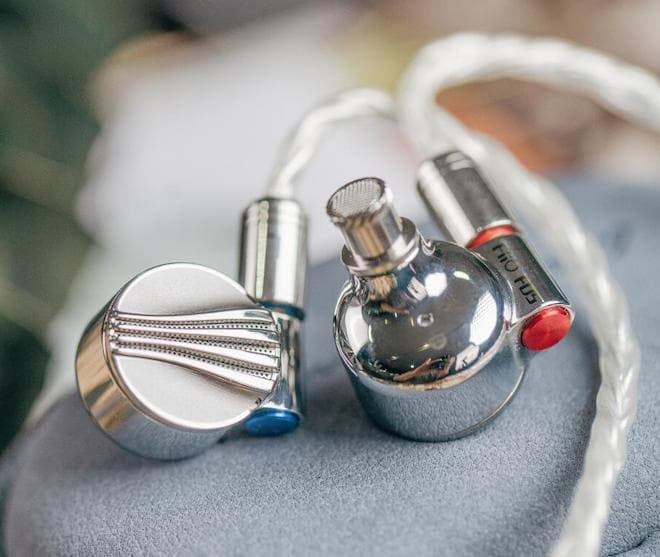
I have been a fan of Pat Metheny for years, but until this past year, Brad Mehldau has been below my radar. I know, I know, they did two albums together. Please don’t judge. Ever since my Mehldau epiphany, his trio has been finding a high rotation on my system. One of my favorites is “Anything Goes”, a collection of covers of songs ranging from Cole Porter to Radiohead. I love listening to a jazz trio because the interplay of the instruments is so textural with the dynamic ebb and flow of the music. Listening to this album with the FD5 IEMs, Mehldau’s piano is forward in my cerebrum, Jorge Rossy’s drums are spread across from ear-to-ear, and Larry Grenadier’s bass is firmly planted in my midbrain. The soundstage inside my head seems to top out at eye level extending down to my chin. It is both trippy and cool at the same time.
Before I continue, I do need to comment how tricky I found it to find the right volume levels with the FD5 IEMs. For me, there seems to be a fine line between too soft to experience the full dynamics and too darn loud. Even though the FD5 IEMs are a semi-open design, they do have a driver only millimeters from your eardrum. Luckily for me, the iDSD has an IEM attenuator switch to give you finer control of the volume. Still, there were some times after a listening session where I knew I had crossed the line and my ears were ringing.
One of the big advantages IEMs have over traditional headphones is their portability. When I’m working on my laptop, like right now, I love to listen to music. So far, I have not been that psyched about music streaming services I’ve tried, since they usually have a poor selection of jazz and classical music. So, I’ve stuck with YouTube, where I can explore new music that I can purchase later. Yes, YouTube is not always the best audio source, but it will do for background music. One of the pieces I’m exploring right now is Esa-Pekka Salonen’s Cello Concerto. He wrote this piece for Yo-Yo Ma. It’s devilishly difficult, but Yo-Yo navigates all of its twists and turns like a true virtuoso. Listening to this piece with FD5 IEMs plugged into my laptop, I was struck at how much of the music was coming through. Sure, it’s not to the level of resolution of my regular system, but I never experienced any cringe moments either.
Like I said, one of the ways I use YouTube is to audition different pieces of music. Sometimes I’m even looking for different performances of the same piece. One of the ones I’ve been looking at is Stravinsky’s Violin Concerto. There are a lot of performances out there to try. My current front runner is Hilary Hahn’s recording with Sir Neville Marriner and The Academy of St Martin in the Fields. The tempo is brisk in a couple of spots, but Hilary and the orchestra never flinch or waver. I always feel that Igor was a watchmaker in a previous life, the way some pieces fit together. Listening to this piece through the FD5 IEMs I was able to experience many of the subtleties of his arrangement.

I’m not much of a streamer, but I do use my tuner on my tablet to listen to the local classical music station. So to finish up my evaluation, I came full circle to use the FD5 IEMs to listen to classical broadcasting. KMFA, our local station, does a good job of avoiding the processing of their FM signal like most commercial radio stations. This is why I used it to break in the FiiO FD5 IEMs in the first place. Many years ago, I had the opportunity to review a Dynaudio tuner and had some pretty surreal moments listening to the station. Now my little cheap tablet is a far cry from the Dynaudio, but I was still able to derive a lot of pleasure from listening to music using the FiiO FD5 IEMs.
In Conclusion
One of the other great features of IEMs is their ability to block outside noises. As my family can confirm with great annoyance, the FD5 IEMs do a great job of isolating the listener. Even with their semi-open design, they would work well in a noisy setting.
As I said, I like to try new things. The FiiO FD5 IEMs were my first experience with a flagship IEM design. They most definitely altered my expectations for what an IEM could do. No matter which music source I used, I found them to be well-balanced and musically engaging. The FiiO FD5 IEMs are a tremendous value with their quality build and excellent sonics. Once my brain adjusted to their new sonic paradigm, I enjoyed using them tremendously. See, it is worth it to try new things!
★★★★★★★★★★ ★★★★★★★★★★ ★★★★★★★★★★ ★★★★★★★★★★ ★★★★★★★★★★ ★★★★★★★★★★ ★★★★★★★★★★ ★★★★★★★★★★ ★★★★★★★★★★ ★★★★★★★★★★ ★★★★★★★★★★ ★★★★★★★★★★ ★★★★★★★★★★ ★★★★★★★★★★ ★★★★★★★★★★ ★★★★★★★★★★
TonalitySub–bass (10Hz – 60Hz) Mid–bass (80Hz – 200Hz) Midrange (200Hz – 3,000Hz) High Frequencies (3,000Hz On Up) Attack Decay Inner Resolution Soundscape Width Front Soundscape Width Rear Soundscape Depth Soundscape Extension Into Room Imaging Fit And Finish Self Noise Value For The Money
Specifications
Type: In-ear monitor (IEM)
Frequency Response: 10Hz to 40kHz
Driver: 12mm Beryllium coated Diamond-like Carbon dynamic driver
Impedance: 32 Ohms @ 1khz
Sensitivity: 109dB @ 1 mW
Max Input Power: 100nW
Cable: Eight strand monocrystalline silver-plated copper
Connectivity: 3.5mm TRS, 2.5mm TRRS balanced, and 4.4mm TRRRS Pentaconn
Cable Length: 120cm
Weight: 11 Grams
Price: $299
Website: FiiO FD5 IEMs
Company Information
GuangZhou FiiO Electronics Technology CO., LTD
Room 901, Building Kaiyue
Huangshi West Road
Baiyun District, GuangZhou
China



